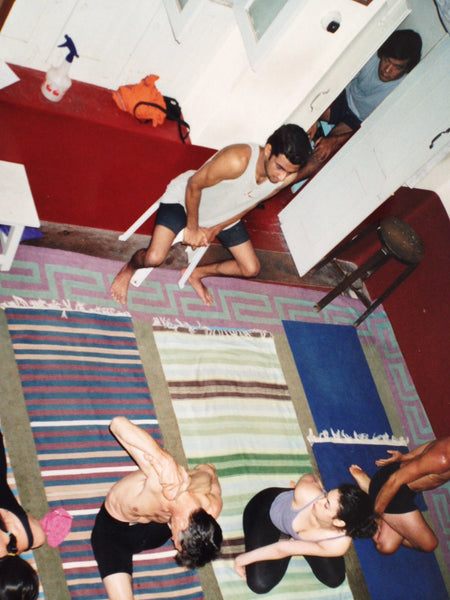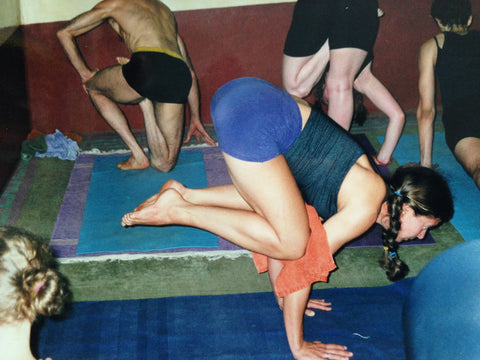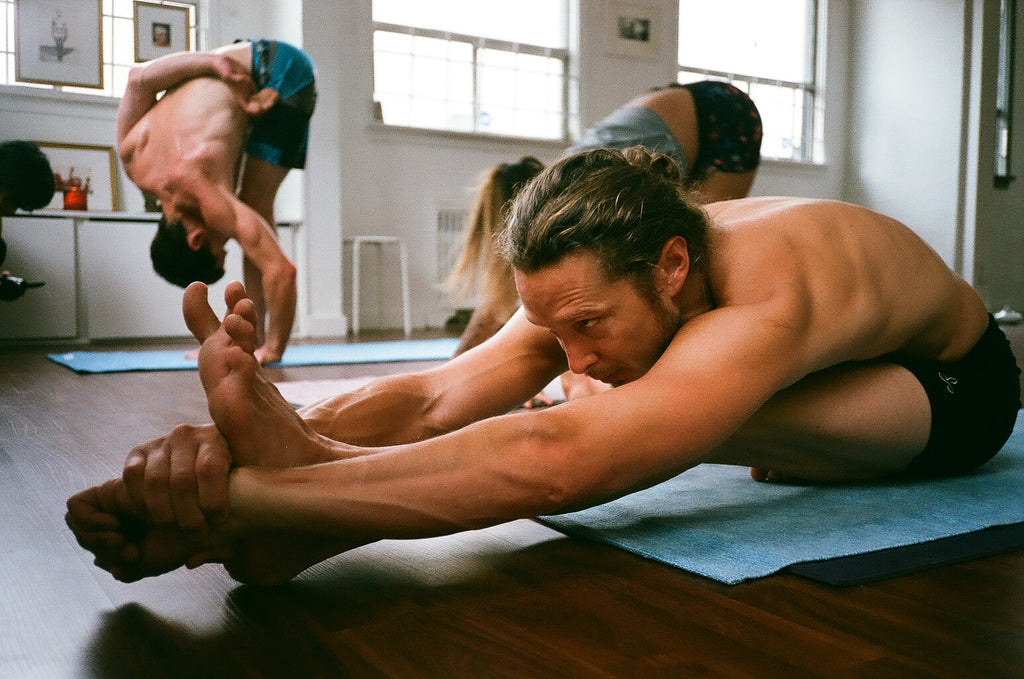
DISCLAIMER: Normally I don't write about the physical aspects of a yoga practice for the one reason is that its so individual and what is good for one person is not good for another.
What you are about to read is information. You and your teacher should decide if it's applicable to you or not. Don't have a teacher? You can find one here
What you will learn by reading this post.
1. The best mat to use for your yoga practice (for both you and the planet). I've learned this first hand from experience and from the source of 99% of the Yoga you see being practiced today.
2. Why you will only need to make this purchase once in your life which will help you save money as well as have less impact on Mother Nature.
3. How & why the original yoga mat switched to the one you commonly see today, Why you want to avoid that because it can lead to massive downsides.
4. What the teacher's of our teacher's chose for practice & why that is different than what businessmen choose.
5. Why this is the best mat for the outdoors & travelling
Ready?
You're not going to believe this.
I still can't believe that in 13 years of practicing I never put these pieces together.
Ok it's not the most shocking news ever (unless you practice yoga everyday)
The sticky mat is a prop.
I know. Mind blowing;)
Why you say? Let me tell you the story.
The reason a sticky mat was invented was because the inventor, Angela Farmer, had a medical condition where she didn't sweat.
Yeah.....didn't sweat.
So she invented a sticky mat.....I don't blame her I would too. It's a crazy story,
"Those of you who can remember the days before color television will also remember what it was like to do yoga without a sticky mat… slippery. “My feet would slide apart and I had to tense my legs to keep from falling,” yoga teacher Angela Farmer recalls. “I was desperate to find something that would give me traction.” So Farmer tried doing yoga on blankets, bulky foam mattresses, and even spat on her dry footsoles to keep from slipping, but nothing really worked.
One day while traveling in Germany, Farmer spotted a roll of matting at a local market. She squeezed the material between her fingers. It was thin, dense, and sticky. It was carpet padding. She bought a length of it and took it to yoga class. “It was heaven,” Farmer recalls. She was able to grip the floor without straining. Farmer took this miraculous mat home to London, where other yogis took interest. Soon Farmer began toting rolls of carpet padding home every time she traveled to Germany. Richard Farmer, Angela’s father, saw an opportunity. He contacted the padding manufacturer and soon became the first retailer of “sticky” mats, calling his new product “The Original Molivos Mat” in honor of his daughter, who led yoga workshops in Molivos, Greece. Export duties and international shipping costs made these European mats expensive in North America. Enter Sara Chambers, of Hugger Mugger, who decided to manufacture her own. With a chemist’s help, she designed the first sticky mat specifically for yoga." - yogajournal.com
Difference between Tools & Products In Yoga
You see what happened here?
Business got involved.
One person with a unique condition (not sweating) solved her problem which by the sounds of it was necessary.
Next a business created a product and well now everybody is using that solution but they don't have the problem to start with.
I certainly don't. For me it's the opposite. Like most people I sweat when I start practicing.
Now businessmen also invented the Microfiber Yoga Towel to go on top of the mat to solve this problem.
But let's take a step back before all that and look at what the first people who learned in Mysore India from Sri K Pattahbi Jois and his Grandson Sharath Jois chose?
Chose.
This is key to the difference between a tool and a product because their motivation wasn't to sell something to you with the latest feature but to find the best solution for their practice.
I know one of the first students so I asked him. His name is Mark Darby.
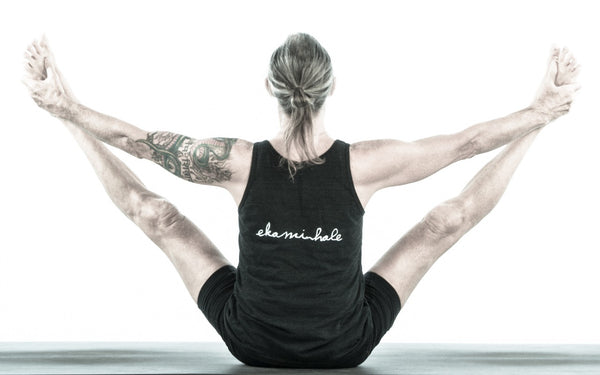
I asked Mark what they did in the early years of with Pattahbi Jois.
Here's what he told me.
"We practiced on the mat that was on the floor in the old shala. No sticky mats back then or any decent cotton mats. The Indians used small towels to catch the sweat. Eventually we found loose weave mats that would stretch and fall apart fairly quickly. After a few years we found mats made from leftover silk that was matted together. Once we started to sweat these were good. Actually it was a great benefits as we had to grip the floor so as not to slide. Something that you don't have to do with sticky mats." - Certified Ashtanga Teacher Mark Darby
The first shala had carpet floors as you can see in these pics here
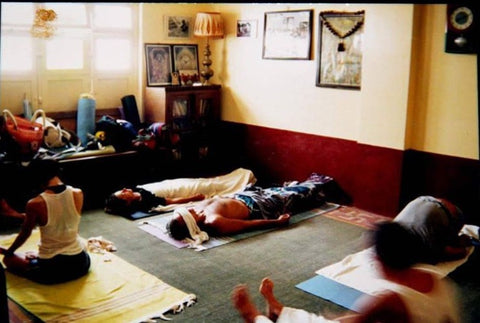
If you look back a bit further to the teacher of teacher's, the father of modern yoga and the Guru of Sri. K Pattahbi Jois you will see the same.
According to AG Mohan's book, Krishnamacharya , his life and teachings, Krishnamacharya taught standing postures on the floor then they used a blanket or rug for seated postures.
Just Google some older video's like this one below and you'll see
And when they were practicing outdoors? They used a rug because it works the best.
Should We Use Props in Yoga?
Now you may be thinking.... Who cares?????
Let's talk about props for a second ok?
It's always a hot topic in the Ashtanga community because when you go to Mysore India to practice at KPJAYI, you quickly learn that there are no props in the shala.
There is no closet full of little foam blocks or cushions. Well actually that's not totally true. There is one prop. I mean literally one. Pretty funny. Definitely necessary.
Compare that to your local shala or studio where it's almost expected to have props. I don't even want to get into the whole debate because opinions differ so widely so let's just say that if you decide to use a prop in your practice that a few conditions need to be met
1. The end result should be that it benefits you.
2. You actually need it
Agreed? Good. Let's keep going.
So what happens when you use a prop and you don't need it?
What Are You Becoming? A Sitting Ninja or Pashasana Ninja?

Let's use the example of another prop we use and the effects that it has on our bodies.
The chair.
In the West we are always trying to make our lives easier. More comfortable. Softer beds, softer couches, less walking……you know what I mean right?
We don't want to sit on the floor so we've got chairs everywhere. You literally can't get away from them and if you do sit on the floor people look at you weird.
In the book Move Your DNA, Restore Your Health Through Natural Movement - by Katy Bowman, MS, she talks about how our modern lifestyle has turned us into “Sitting Ninjas”.
We’re getting really good at sitting in chairs because that’s all we do all day. This excessive sitting in chairs leads to physical consequences .
One is not having the ability to squat.
What happens if you remove the chair?
Well when I was in India that was one of the first things I noticed.
Way less chairs. Way less props. What does a person do if they don't have a chair? They sit on the ground or squat. What is the result?
Baddha Konasana

Pashasana

Is A Sticky Mat Helping or Hurting Your Practice?
Let's apply the same logic to the sticky mat.
Is it beneficial? or is stopping you from building the strength you need?
Angela said in the Yoga Journal Interview
“My feet would slide apart and I had to tense my legs to keep from falling,”
My question to you reading this is......is this a bad thing? Of course if you have the same condition as her you would be squeezing too hard but what about just enough? Enough that you are actually getting stronger.
This is not the first time this has been pointed out.
Three very important teacher's have pointed to this. One is another of the first Westerner's who went to Mysore....Nancy Gilgoff
"During her adjustment clinic in Los Angeles last week, Nancy (Gilgoff) made no ifs, ands or buts about it: According to her, you should be laying that yoga rug down on your sticky mat before you say the opening chant. And leave it there.
But back to the rug. According to Nancy, you shouldn’t be taking time out in the middle of your practice to roll it out, or squirt it with water or anything else that draws away your focus and your breath. And being able to stay balanced on the rug is the point, and will help you build strength."
Confluence Countdown Blog Post - A Brief History of Yoga Mats
Darby showed me this when I was studying with him. We did this exercise which I don't recommend because its a mild form of torture but it drills the point home.
What you do is take a soft blanket. Usually they have them in yoga shalas to put on people if they are cold during rest.
Next you set it on the floor which is usually a wood or laminate floor in the western version of shala aka Yoga Studio. Since this floor is slippery the blankets slides around easily on it.
Next you make a little fold in the middle so it kind of sticks up like a ridge through the center.
This is your new yoga mat and your job is to not let the fold smoothen out (when the ends of blanket move away from each other) as you do the standing postures.
Its the complete opposite of sticky mat shows you how much are you relying on the stickiness of your mat to stop your feet from sliding apart. Or the other way of looking at it - how little you are using other muscles to keep them together.
The third source to point out the importance of cultivating strength is non other than Patanjali in the Yoga Sutra's.
Sthira sukham āsanam.
Sthira means strength & foundation while sukham means comfortableness & ease. I don't think I need to say more.
So What is the Best Yoga Mat for today?
It's still the rug with one slight modification.
(I wrote all the reason why a rug is best for practice and the planet in my most popular post 12 Reasons to put a Mysore Rug on your Sticky Mat)
Unlike the first shala most yoga studio's floors are not rug and even KPJAYI has laminate floors now. The floors are usually laminate or hardwood.
To account for this I always recommend using a mat under a Yoga rug.
It keeps the rug in place, it allows you the option to use the sticky mat if you want more grip, provides a bit of cushioning from the hard floors and keeps the rug clean from the dirt on the floor.
Im currently using the Manduka Pro under my rug. This mat is bulletproof and it is going to last forever which is why they offer a lifetime guarantee. It's made of PVC and I can't imagine it being too biodegradable but because of that fact I plan on using mine my whole (not buying more) and giving it to my kids to use after I'm done my time here.
(I'm looking for some other options for the under layer that are biodegradeable. If you have been using one you like send me an email please)
Best Yoga Mat For Outdoors
Although we do our practice indoors for those people who do so on the grass or beach there is no better choice than the rug. I mean thats what Krisnamacharya and BKS Iyengar used in those old videos above.
They don't get hot and slippery like synthetic material and the most important is that you are grounded. Which means you are receiving the electrical charge from the earth that heals and calms you.
If you want to see the Mysore Rugs I sell which are the best ones you can find online click here - Ekaminhale Handloomed GOTS Certified Mysore Rugs
Before you go let me tell you about the one prop they have in Mysore.
The One Prop You May Need
Before you go I want to tell you about that prop at KPJAYI.
One day on my first trip I was practicing and I heard this BOOM. It was like a churchbell except it was someone's head hitting the cement floor in dropbacks.
I thought. Wow. Someone is going the hospital. Then I heard it again.
Later I found out it was my friend Ian. He said it that it didn't actually hurt that bad but what happens if you have that issue of coming in a little shallow on the dropbacks then you get to use a pillow so your head doesn't smack the floor.
See what I mean? Now THAT is a prop that is necessary.

Love to hear your thoughts....Comment Below.
Clint


